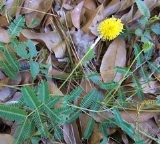
Neptunia lutea
Encyclopedia
Neptunia lutea, the Yellow-puff, is a trailing, vine-like perennial plant
of the legume family Fabaeceae. Its stems are covered with soft spines, but is not nearly as prickly as its cousin, the Sensitive Brier (Mimosa nuttallii
).
The sprawling stems of this plant branch frequently, with each branch growing as long as 5 ft. Leaves
are alternate and stalked, bipinnate, looking much like tiny fern frond
s. The flower
s are tiny and arranged in a slightly elongated, congested bundle (inflorescence) containing 30-60 flowers each. The unopened bud clusters look much like green bramble fruits. Each individual flower has five minute pedals and ten stamen
s. When the flowers open, the inflorescence looks like a puffy yellow ball, with usually only the long yellow stamens visible. The inflorescence rests solitary at the end of a slender stalk.
This plant grows best in full sun to partial shade. It inhabits the various soil
s of forest margins, the openings of thickets, roadsides, prairies and pastures.
Like the related Sensitive Plant and Sensitive Brier, the leaves of this plant exhibit rapid plant movement
. They will close upon touch, as well as at night and during periods of cloudy weather.
Perennial plant
A perennial plant or simply perennial is a plant that lives for more than two years. The term is often used to differentiate a plant from shorter lived annuals and biennials. The term is sometimes misused by commercial gardeners or horticulturalists to describe only herbaceous perennials...
of the legume family Fabaeceae. Its stems are covered with soft spines, but is not nearly as prickly as its cousin, the Sensitive Brier (Mimosa nuttallii
Mimosa nuttallii
Mimosa nuttallii, the Catclaw Brier or Sensitive Brier, is a herbaceous perennial legume in the subfamily Mimosoideae. It has a trailing semiwoody vine covered with small recurved prickles that can be painful to bare skin....
).
The sprawling stems of this plant branch frequently, with each branch growing as long as 5 ft. Leaves
Leaf
A leaf is an organ of a vascular plant, as defined in botanical terms, and in particular in plant morphology. Foliage is a mass noun that refers to leaves as a feature of plants....
are alternate and stalked, bipinnate, looking much like tiny fern frond
Frond
The term frond refers to a large, divided leaf. In both common usage and botanical nomenclature, the leaves of ferns are referred to as fronds and some botanists restrict the term to this group...
s. The flower
Flower
A flower, sometimes known as a bloom or blossom, is the reproductive structure found in flowering plants . The biological function of a flower is to effect reproduction, usually by providing a mechanism for the union of sperm with eggs...
s are tiny and arranged in a slightly elongated, congested bundle (inflorescence) containing 30-60 flowers each. The unopened bud clusters look much like green bramble fruits. Each individual flower has five minute pedals and ten stamen
Stamen
The stamen is the pollen producing reproductive organ of a flower...
s. When the flowers open, the inflorescence looks like a puffy yellow ball, with usually only the long yellow stamens visible. The inflorescence rests solitary at the end of a slender stalk.
This plant grows best in full sun to partial shade. It inhabits the various soil
Soil
Soil is a natural body consisting of layers of mineral constituents of variable thicknesses, which differ from the parent materials in their morphological, physical, chemical, and mineralogical characteristics...
s of forest margins, the openings of thickets, roadsides, prairies and pastures.
Like the related Sensitive Plant and Sensitive Brier, the leaves of this plant exhibit rapid plant movement
Rapid plant movement
Rapid plant movement encompasses movement in plant structures occurring over a very short period of time, usually under one second. For example, the Venus Flytrap closes its trap in about 100 milliseconds. The Dogwood Bunchberry's flower opens its petals and fires pollen in less than 0.5 milliseconds...
. They will close upon touch, as well as at night and during periods of cloudy weather.

